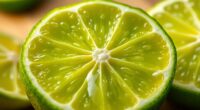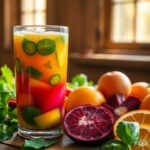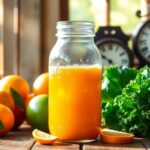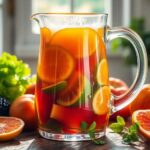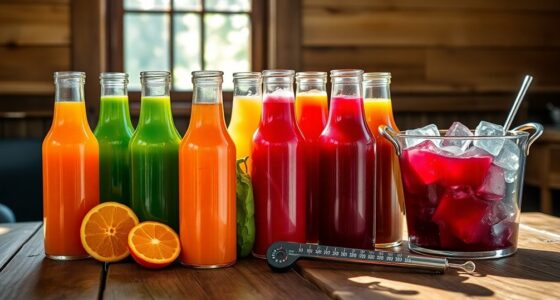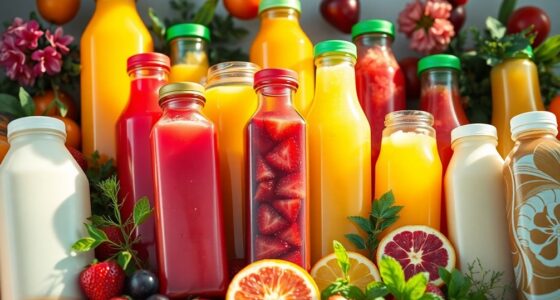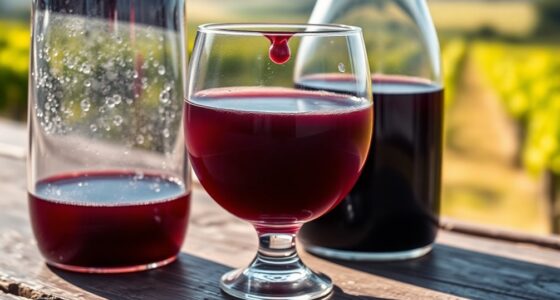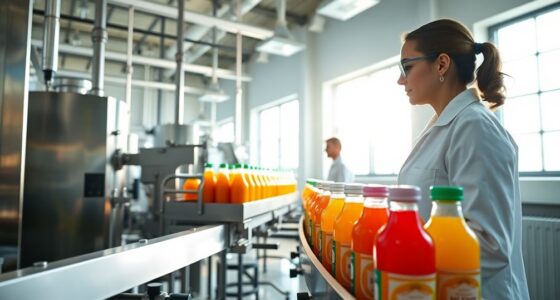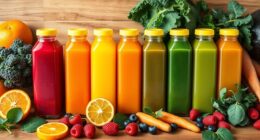Fresh juice typically lasts between 24 to 72 hours in the fridge, influenced by factors like the juicing method and storage conditions. Centrifugal juicer juices spoil faster, usually within 24 hours, while masticating and twin-gear juicers can keep juice fresh for up to three and five days, respectively. Storing juice in airtight containers at 35-40°F maximizes freshness. Want to know more about prolonging its life and nutrients? There's plenty to uncover!
Key Takeaways
- Fresh juice typically lasts between 24 to 72 hours when stored in the fridge, depending on the juicer type used.
- Centrifugal juicer juice has a shorter shelf life of about 24 hours due to faster oxidation.
- Masticating juicer juice can last up to three days, while twin-gear juicers extend freshness to 4-5 days.
- Store juice in airtight glass containers at 35-40°F, filling them to the brim to minimize air exposure.
- Signs of spoilage include strong odors, a brown surface layer, and sour taste; trust sensory indicators for safety.
How Long Does Fresh Juice Last in the Fridge?

When it comes to fresh juice, knowing its lifespan in the fridge is essential for maintaining its freshness and flavor.
Fresh juice typically lasts between 24 to 72 hours, depending on how you store it. If you use a centrifugal juicer, expect a shelf life of about 24 hours, while juice from a masticating juicer can last up to three days.
To maximize freshness, always store juice in airtight containers and keep it at 35-40°F. Adding lemon juice can help delay the oxidation process, extending the shelf life.
For long-term storage, freezing juice is an option, allowing it to last up to six months, but consuming it within two to three months is best for ideal taste and nutrition.
Factors Affecting the Shelf Life of Fresh Juice
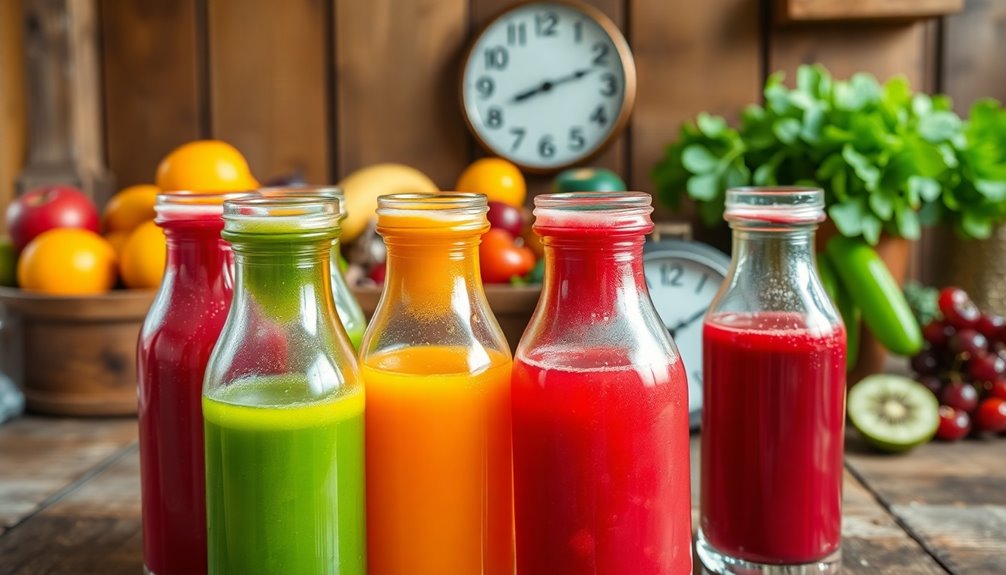
The type of juicer you use can greatly influence how long your fresh juice lasts.
If you're using a centrifugal juicer, you might notice your juice spoils faster compared to one made with a masticating or twin-gear juicer.
Additionally, the freshness and quality of the fruits and vegetables you choose play an essential role in extending the juice's shelf life. For instance, using fresh ingredients will help maximize nutrient retention and flavor, contributing to a longer shelf life for your juice.
Juicer Type Impact
Different juicer types greatly impact the shelf life of fresh juice, with each method offering unique benefits and drawbacks.
Here's how different juicers affect juice lifespan:
- Centrifugal Juicer: Juice lasts up to 24 hours due to high-speed oxidation.
- Masticating Juicer: Extends juice lifespan to about 48 hours, reducing oxidation with lower speeds.
- Twin-Gear Juicer: Preserves juice freshness for 4 to 5 days, minimizing air exposure effectively.
- Produce Quality: Fresh, organic ingredients yield longer-lasting juice compared to expired or overripe produce.
To maximize shelf life, always use proper storage techniques like airtight containers and ideal refrigeration.
Understanding how your juicer type influences oxidation and produce freshness can help you enjoy your juice longer!
Produce Freshness Quality
Although you might not realize it, the freshness of your produce plays a crucial role in determining how long your juice will last. Using fresh, organic fruits and vegetables helps extend the shelf life of your juice. Expired or overly ripe ingredients accelerate spoilage and reduce nutritional content. Additionally, the acidity level affects preservation; highly acidic fruits, like citrus, slow down oxidation. For instance, combining juices with high acidity levels can significantly enhance their longevity.
Proper storage is essential; always use airtight glass containers instead of low-quality plastic to minimize oxidation. Ideally, store fresh juice within 20 minutes of juicing to maintain its quality.
| Factors | Impact on Juice Freshness |
|---|---|
| Freshness of Produce | Longer lasting juice |
| Storage Method | Reduces oxidation |
| Type of Juicer | Affects shelf life |
| Acidity Level | Slows down spoilage |
Tips for Extending the Freshness of Your Juice

To keep your juice fresh and flavorful for as long as possible, proper storage techniques are essential. Here are some tips to extend the freshness of your juice: To keep your juice fresh and flavorful for as long as possible, proper storage techniques are essential. Here are some tips to extend the freshness of your juice: Use airtight containers to minimize exposure to air, which can lead to oxidation and spoilage. Additionally, store your juice in the refrigerator as soon as possible and consume it within a few days for optimal taste. For those looking for the best juice packaging methods, consider using dark glass bottles which help protect the juice from light degradation, further preserving its nutrients and flavor.
- Store in Airtight Containers: Use glass containers to minimize oxidation and preserve taste.
- Fill to the Brim: Reduce air exposure by filling your juice containers to the top, slowing spoilage.
- Add Lemon Juice: Incorporate lemon juice as a natural preservative to enhance shelf life and delay oxidation.
- Freeze in Portions: Freeze juice in small portions to extend its shelf life up to 6 months, with ideal flavor if consumed within 2-3 months.
Best Practices for Storing Fresh Juice

Storing fresh juice properly is key to maintaining its flavor and nutritional value. To achieve this, always store your juice in airtight glass containers, which limit oxygen exposure and help preserve taste and nutrients.
Refrigerate juice at a temperature between 35-40°F (1.6-4.4°C) to slow degradation and prevent bacterial growth. Fill the containers to the top to minimize air space, reducing oxidation and maintaining color.
Consider adding lemon juice, as it acts as a natural preservative, delaying oxidation and extending the juice's freshness. For ideal taste and nutrition, consume fresh juice within 72 hours. Additionally, incorporating juices rich in vitamins A, C, and E can enhance skin health while enjoying your fresh juice.
Signs That Your Juice Has Spoiled
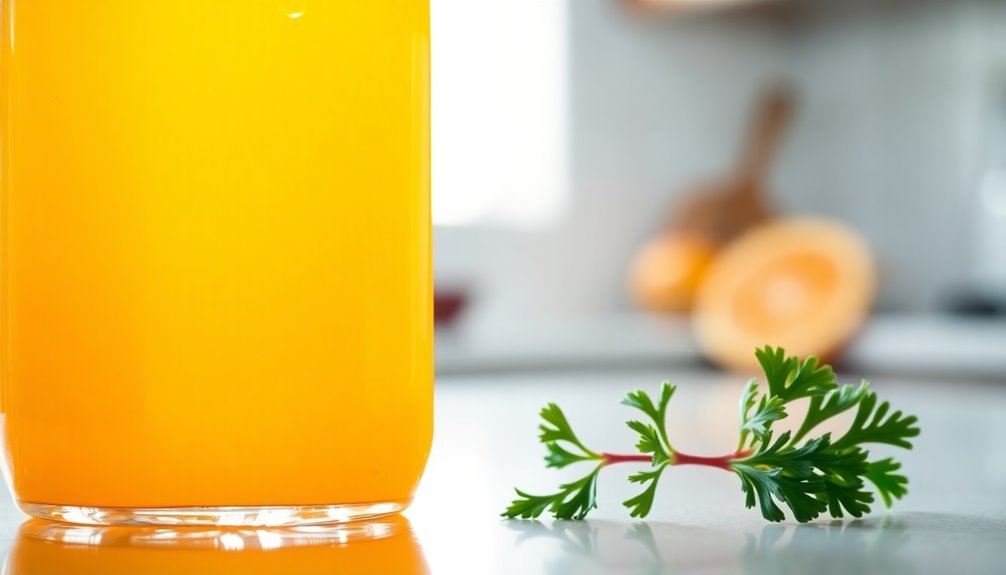
When you open a bottle of fresh juice, it's important to check for signs of spoilage to guarantee it's safe to drink.
Here are some key indicators to watch for:
- Strong odor: A putrid smell means it's spoiled and not safe to consume.
- Brown layer: If you see a brown layer on the surface, oxidation has likely occurred, indicating potential spoilage.
- Sour taste: A sour flavor is a definitive sign that the juice has fermented and should be discarded.
- Unusual changes: Look for darkening, separation, or altered consistency, like thickness or sliminess, which all suggest spoilage.
Trust your senses; if you notice any of these signs, it's best to toss the juice.
Nutrient Retention in Fresh Juice
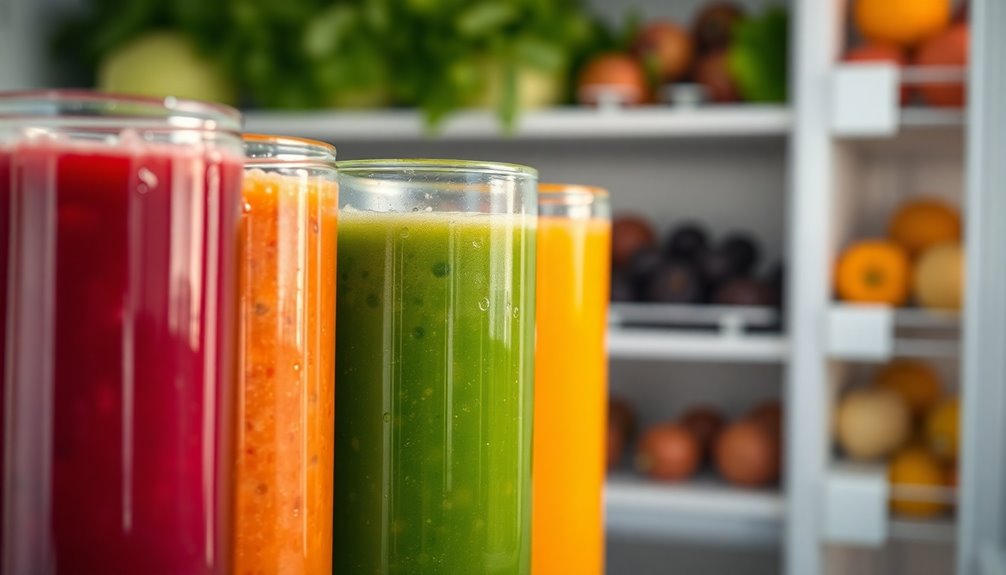
When you make fresh juice, it's essential to drink it right away for the best nutrient retention.
Nutrients can start to diminish within just 20-30 minutes of exposure to air, so immediate consumption maximizes your health benefits.
Nutrient Loss Over Time
Although fresh juice is packed with nutrients, its benefits can diminish rapidly once exposed to air. This nutrient degradation typically begins within 20-30 minutes, so you want to drink it soon for the best taste.
Here are some tips to maintain your juice's nutrient content:
- Choose cold-pressed juice for higher nutrient retention, up to 90%.
- Add citrus fruits like lemon to slow down vitamin breakdown.
- Use preservation techniques like freezing, which can prolong shelf life for up to three months.
- Avoid prolonged exposure to air by sealing your juice tightly in containers.
Benefits of Immediate Consumption
Consuming fresh juice immediately after extraction is essential for maximizing its health benefits, as nutrients begin to degrade quickly once exposed to air.
When you drink juice within 20-30 minutes, you guarantee that the vitamins, antioxidants, and digestive enzymes are at their most effective, especially in cold-pressed juices.
Nutritional degradation occurs rapidly, and significant losses can happen within 72 hours.
By prioritizing immediate consumption, you're giving your body the maximum amount of nutrients from fresh fruits and vegetables, boosting your immune system and overall health.
Remember, the longer you wait, the more nutrients you lose. Additionally, fresh juice packed with vitamins can significantly enhance your daily nutrient intake and overall wellness.
Frequently Asked Questions
How Long Do Fresh Juices Last in the Fridge?
Fresh juices can last anywhere from 24 to 72 hours in your fridge, depending on how you store them.
If you use a centrifugal juicer, expect a shorter lifespan—about 24 hours.
For better preservation, keep your juice in airtight glass containers and at a temperature of 35-40°F.
Adding some citrus juice can help extend freshness, and if you want to keep it longer, freezing it for up to six months is a good option.
Can You Drink Juice After 7 Days?
They say, "Better safe than sorry."
After 7 days, it's best not to drink that juice. Consuming it could pose safety risks due to bacterial growth and nutrient loss.
If you notice any odd smells, colors, or a sour taste, it's a sure sign to toss it out. Always prioritize your health!
Stick to that 3-5 day window for the freshest and safest juice experience. Your body will thank you!
How Long Does Fresh Juice Last in a Mason Jar?
If you store fresh juice in a mason jar, it can last between 24 to 72 hours in the fridge.
To get the best taste and nutrition, try to consume it within the first 24 hours.
Make sure to fill the jar to the brim to reduce air exposure, and keep it sealed tight.
For even better preservation, consider adding a splash of lemon juice before sealing it up.
Can Unopened Juice Go Bad in the Fridge?
Yes, unopened juice can go bad in the fridge. If it's stored improperly or kept at temperatures above 41°F (5°C), spoilage can occur even before the expiration date.
You should always check for signs like color changes, off-putting odors, or bulging packaging, which indicate fermentation or contamination.
It's essential to follow the expiration date on the label, as consuming expired juice can pose health risks.
Stay safe by staying aware!
Conclusion
So, there you have it! Fresh juice isn't exactly a vampire; it won't last forever in your fridge just because it's packed with vitamins. Treat it like the diva it is—consume it within a few days, or risk it turning into a science experiment with a funky odor. Remember, no one wants to discover a bubbling, moldy monster lurking behind their kale. Keep those nutrients vibrant and your fridge clean—sip that juice before it decides to stage a dramatic exit!
Cindy thoroughly researches juicing trends, techniques, and recipes to provide readers with practical advice and inspiration. Her writing style is accessible, engaging, and designed to make complex concepts easy to understand. Cindy’s dedication to promoting the advantages of juicing shines through her work, empowering readers to make positive changes in their lives through the simple act of juicing.


